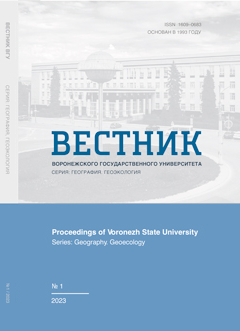Оценка уровня связи заболеваемости поллинозами с произрастанием аллергенных растений на территории Воронежской области
Аннотация
Масштабное распространение аллергической заболеваемости является актуальной социальной и экономической проблемой здравоохранения различных стран. Цель – проверка гипотезы связи между средним многолетним уровнем заболеваемости поллинозами, показателем лесистости и фактом наличия амброзии на территории Воронежской области. Материалы и методы. Материалами для анализа послужили статистические учетно-отчетные формы № 12 за период с 2012 по 2021 годы, а также результаты региональных исследований лесистости и распространения амброзии, опубликованные в открытой научной печати. Проведено ретроспективное исследование заболеваемости поллинозами различных групп населения, ранжирование территорий по уровню заболеваемости, корреляционный анализ и оценка достоверности различий между показателями заболеваемости, лесистости и фактом распространения амброзии. Результаты и обсуждение. Отмечена ежегодная регистрация заболеваемости поллинозами на территории Воронежской области во всех возрастных группах населения. На основания ранжирования территорий к первому ранговому месту по уровню заболеваемости отнесен Рамонский район, который также лидирует по уровню лесистости в области. Корреляционный анализ, проведенный между показателем средней многолетней заболеваемости поллинозами, показателем лесистости и фактом распространения амброзии, показал статистически значимую связь средней силы между анализируемыми величинами. Оценка достоверности различий проведена с учетом подбора территорий, которые различаются по анализируемым показателям. Выводы. Подтверждена гипотеза о связи между уровнем заболеваемости населения поллинозами, показателем лесистости и фактом наличия амброзии на территории Воронежской области.
Скачивания
Литература
Vinogradov P. M. Otsenka kachestva sredy obitaniya goroda Voronezha na osnove integral'nogo pokazatelya stabil'nosti razvitiya berezy povisloy (Betula pendula roth.) i topolya piramidal'nogo (Populus pyramidalis borkh.) [Assessment of the quality of the habitat of the city of Voronezh based on the integral indicator of the stability of the development of the hanging birch (Betula pendula roth.) and the pyramidal poplar (Populus pyramidalis borkh.)]. Sovremennye problemy nauki i obrazovaniya, 2014, no. 6, pp. 1678. (In Russ.)
Vladimirov D. R. Ekologicheskaya opasnost' invazionnoy fraktsii fl ory Voronezhskoy oblasti [Ecological danger of the invasive fraction of the fl ora of the Voronezh region]. Vestnik Voronezhskogo gosudarstvennogo universiteta. Seria: Geografi a. Geoekologia, 2014, no. 4, pp. 34-38. (In Russ.)
Grigor'evskaya A. Ya., Lepeshkina L. A., Vladimirov D. R. Analiz adventivnogo komponenta fl ory gorodskogo okruga g. Voronezh [Analysis of the adventive component of the fl ora of the Voronezh city district]. Materialy 4 mezhdunarodnoy nauchnoy konferentsii «Problemy izucheniya adventivnoy i sinantropnoy fl or Rossii i stran blizhnego zarubezh'ya», 2012, pp. 62-64. (In Russ.)
Mel'nikov V. L., Mitrofanova N. N., Mel'nikov L. V. Allergicheskie zabolevaniya: uchebnoe posobie [Allergic diseases: a textbook]. Penza: Izdatel'stvo PGU, 2015. 88 p. (In Russ.)
Nesterov Yu. A., Stepanenkova A. A., Zhigulina K. M. Kartografi rovanie lesistosti territorii sredstvami geoinformatsionnykh sistem (na primere Voronezhskoy oblasti) [Mapping of the forest cover of the territory by means of geoinformation systems (on the example of the Voronezh region)]. Materialy X Vserossiyskoy nauchno-prakticheskoy konferentsii «Geoinformatsionnoe kartografi rovanie v regionakh Rossii», 2018, pp. 109-116. (In Russ.)
Sovremennye napravleniya okazaniya pomoshchi bol'nym allergicheskim rinitom v svete trebovaniy pretsizionnoy meditsiny M. R. Khaitov / Namazova-Baranova L. S., Chuchalin A. G. i dr. [Modern directions of care for patients with allergic rhinitis in the light of the requirements of precision medicine M. R. Khaitov]. Rossiyskiy allergologicheskiy zhurnal, 2017, no. 14-3, pp. 46-54. (In Russ.)











